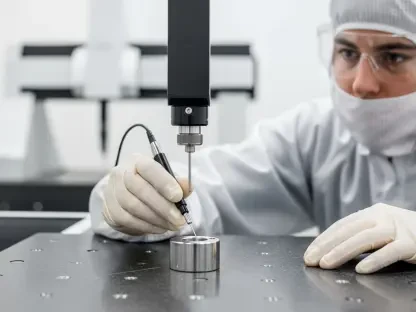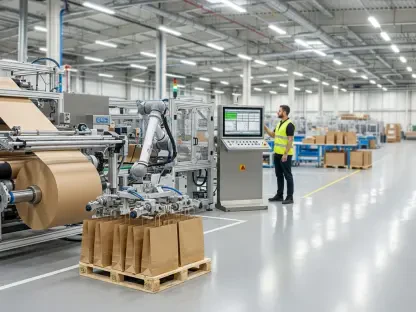Additive manufacturing (AM), often referred to as 3D printing, is fundamentally changing the aerospace industry by offering groundbreaking ways to design, produce, and maintain critical components with unmatched precision and efficiency. This innovative technology allows for the creation of complex, lightweight parts that address pressing demands for enhanced performance, reduced costs, and environmental sustainability. The aerospace AM market, valued at USD 1.82 billion in 2024, is on a remarkable growth path, projected to reach USD 15.0 billion by 2035 with a compound annual growth rate (CAGR) of 21.1%. Such exponential expansion highlights the industry’s urgent need for manufacturing solutions that not only improve operational outcomes but also align with global sustainability targets. The impact of AM extends far beyond mere technical advancements, reshaping entire operational frameworks across commercial aviation, defense, and space exploration. Companies are increasingly adopting this technology to maintain a competitive edge in a rapidly evolving sector where agility and innovation are paramount. By enabling on-demand production and localized manufacturing, AM is poised to redefine supply chains and minimize costly downtimes. This transformation signals a shift toward a future where digital manufacturing becomes the backbone of aerospace progress, setting the stage for a deeper exploration of its multifaceted benefits and challenges.
Revolutionizing Design with Lightweight Complexity
Additive manufacturing stands out in aerospace for its unparalleled ability to produce lightweight and intricately designed components that traditional methods struggle to replicate. Techniques such as selective laser melting (SLM) and electron beam melting (EBM) facilitate the creation of parts with sophisticated geometries, optimizing strength while significantly reducing weight. This is a critical advantage in an industry where every ounce saved translates to improved fuel efficiency and lower carbon emissions. Engine components, for example, can now be reimagined with internal structures that enhance performance without adding bulk, pushing the boundaries of what aircraft can achieve. The adoption of AM for such designs is not merely a trend but a strategic move to address long-standing challenges in aerospace engineering, ensuring that performance and efficiency go hand in hand.
Beyond the technical feats, the emphasis on lightweight design through AM carries profound economic implications for aerospace companies. Reducing an aircraft’s weight directly correlates with substantial fuel savings over its operational lifespan, a factor that can make or break profitability in a highly competitive market. Major industry players are leveraging this technology to develop parts that are not only lighter but also more resilient, setting new standards for durability and functionality. This shift is evident in the redesign of airframe elements and structural supports, where AM enables configurations that were once deemed impossible. As a result, the technology fosters a culture of innovation, encouraging engineers to rethink conventional approaches and embrace designs that maximize both performance and cost-effectiveness.
Streamlining Costs and Supply Chains
One of the most transformative aspects of additive manufacturing in aerospace is its potential to drive cost efficiency by minimizing material waste. Unlike subtractive manufacturing, which removes excess material and generates significant scrap, AM builds components layer by layer, using only what is necessary. This approach substantially cuts production expenses, a crucial benefit in an industry where margins are often tight. Additionally, the precision of AM reduces the need for extensive post-processing, further lowering costs. Aerospace firms are increasingly recognizing this economic advantage, integrating AM into their workflows to produce high-value parts without the traditional financial burden, thus enhancing their bottom line while maintaining quality standards.
Equally significant is how AM is revolutionizing supply chain dynamics within the aerospace sector. By enabling on-demand production, parts can be manufactured closer to the point of need, whether at a regional maintenance hub or even on-site during critical operations. This capability slashes inventory costs and shortens lead times, addressing the perennial issue of aircraft downtime, which can be extraordinarily expensive. The shift toward localized production also mitigates risks associated with global logistics disruptions, ensuring a more resilient supply chain. For military applications, this is particularly vital, as rapid access to spare parts in remote locations can be a matter of mission success. Through AM, the industry is moving toward a more agile and responsive framework, fundamentally altering how resources are managed and deployed.
Championing Sustainability in Aviation
Sustainability has emerged as a core driver behind the adoption of additive manufacturing in the aerospace industry, aligning with global efforts to reduce the environmental impact of aviation. AM supports the use of eco-friendly materials and energy-efficient production methods, significantly cutting down on the carbon footprint of manufacturing processes. Moreover, the technology accelerates prototyping cycles, allowing for rapid design iterations that lead to more sustainable aircraft components. This ability to test and refine designs quickly ensures that innovations aimed at reducing emissions or improving fuel efficiency reach the market faster, supporting the sector’s commitment to meeting stringent environmental regulations.
Another dimension of AM’s contribution to sustainability lies in the rise of distributed manufacturing models. Printing spare parts on-site at maintenance facilities rather than shipping them from centralized locations drastically reduces transportation-related emissions. This approach not only lowers the environmental impact but also enhances operational efficiency by minimizing delays in repairs. As regulatory pressures intensify and corporate sustainability goals become more ambitious, AM provides a viable pathway to achieve these targets without compromising on performance or safety. The technology’s alignment with green initiatives positions it as a cornerstone of future aerospace strategies, ensuring that environmental responsibility remains a priority alongside technological advancement.
Expanding Horizons with Materials and Applications
The versatility of additive manufacturing shines through its diverse applications across the aerospace spectrum, from critical engine components to intricate cabin interiors. Materials such as titanium and nickel alloys are employed for high-stress parts due to their exceptional strength-to-weight ratios, while advanced polymers and composites cater to non-structural elements where lightweight design and flexibility are key. This adaptability allows AM to meet a broad array of industry needs, ensuring that each component is tailored to specific performance requirements. Whether it’s enhancing the durability of turbine blades or reducing the weight of passenger seating, AM offers solutions that span the entire aircraft, driving efficiency and innovation at every level.
Material innovation continues to expand the potential of AM in aerospace, with ongoing research yielding new composites and high-performance alloys. These developments are crucial for tackling increasingly complex challenges, such as creating parts that withstand extreme temperatures or stress in space environments. The ability to customize materials for specific applications opens up possibilities for entirely new categories of components, enhancing safety and operational capabilities. As these advancements unfold, they promise to further integrate AM into mainstream production, ensuring that the technology keeps pace with the evolving demands of commercial aviation, defense, and space exploration. This dynamic landscape underscores AM’s role as a catalyst for pushing the boundaries of what’s possible in aerospace design and functionality.
Leading the Charge with Industry and Technology
Major aerospace companies like Boeing, Airbus, and GE Aviation, alongside technology innovators such as Stratasys and 3D Systems, are at the forefront of driving additive manufacturing’s evolution. Their substantial investments in research and development are unlocking novel applications and refining material performance, setting benchmarks for digital manufacturing. These collaborations are pivotal in scaling AM from niche uses to widespread adoption, ensuring that the technology becomes an integral part of aerospace production. By focusing on innovation, these industry leaders are not only enhancing current capabilities but also laying the groundwork for future breakthroughs that could redefine the sector.
Technological advancements, particularly the integration of artificial intelligence (AI) and hybrid manufacturing systems, are amplifying the impact of AM in aerospace. AI enhances design precision and quality control by minimizing errors and optimizing production workflows, while hybrid systems combine additive and subtractive techniques to achieve superior surface finishes and accuracy. These developments address some of the inherent limitations of standalone AM processes, broadening its applicability for high-precision components. The synergy of such technologies points to a future where manufacturing is not only additive but also intelligent and highly adaptable, promising faster, more reliable production cycles that meet the stringent demands of aviation and space exploration.
Shaping the Future of Aerospace Innovation
Reflecting on the journey of additive manufacturing in aerospace, it’s evident that the technology has carved a path of profound transformation over recent years. Valued at USD 1.82 billion in 2024 and projected to surge to USD 15.0 billion by 2035, the market’s growth mirrors the industry’s urgent need for efficiency and sustainability. Challenges like high initial costs and regulatory complexities have been met with innovative solutions through partnerships among giants like Boeing, Airbus, and technology providers such as Stratasys. The integration of AI and hybrid systems has marked significant milestones, while regional leadership in North America and Europe, alongside rapid growth in Asia-Pacific, showcases AM’s global impact.
Looking ahead, the next steps involve sustained investment in material science and process optimization, which are crucial to sustaining this momentum. Developing a skilled workforce adept in AM technologies will be essential to meet future demands. As in-space fabrication emerges as a frontier for space exploration, continued collaboration across industries will ensure AM remains a cornerstone of next-generation aerospace solutions. These efforts will solidify additive manufacturing’s role as a driver of innovation, ensuring the aerospace sector soars to new heights in efficiency and environmental stewardship.









